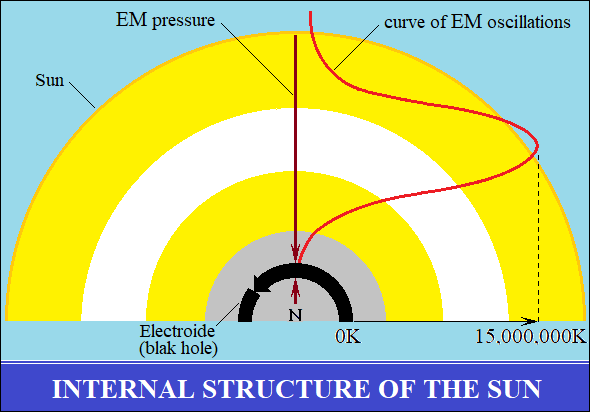The
internal structure of the sun
Current intensity
Corpuscular interpretation.
The intensity of the electric current is defined as
"the electrical charge passing through the surface unit" in
the time unit.
In a DC circuit, the electrical charges move from the negative terminal
to the positive terminal.
In other words, the electric load passes through the surface unit without
stopping,
like the train through the station.
What is the electric charge?
It is a "property of matter", "the atom of electricity",
a "quantity of electricity"
put by do not know who in a sphere of not know what and is called an electron.
The atom was the ancient idea, of finding the fund of matter existence,
of phenomena.
It was a failed philosophical concept, which demonstrated the limits of
our reason.
Habra cadabra ...
The electron is only half of electricity, being only the dorsal, negative
side,
it is a girl, because it is always attracted to its positive half of theelectricity.
The electron had to be solid, the corpuscle, but it is dual (the corpuscle
and the wave).
Its motion in orbit is seen as a wave and not as a corpuscle!
But his movement outside the atom had to remain a corpuscle.
In its movement, the electron collides, cracks, causing the thermal effect
and resistance.
We like it or not, the electron is and now, the essence of the electric
phenomenon!
The bankruptcy of the electron is the failure of the theories supported
per the electron.
The internal structure of the sun
In a star no stratified structure with different chemical composition
is possible.
The conclusion "belong of the electron"
The internal structure of the sun
The electric current
Vector interpretation
The electric current is the simple orientation of the vectors in the direction
and sense.
The notion of "electric current" is inappropriate for vector
interpretation.
Real, it is the "electromagnetic orientation of the vectors"
instead of the current.
In this interpretation, the electromagnetic energy
is the simple orthogonal orientation of the vectors
and so all the structures of matter are organized, from atoms to galaxies.
The intensity of the electric vectors orientation.
The intensity of the electromagnetic orientation of the vectors
is the density of the oriented vectors, into the surface unit.
The intensity of the orientation of the electric vectors
in the circuits can be intrinsic (homogeneous), or extrinsic.
The intensity of the orientation of the vectors in intrinsic electrical
circuits
is generated only naturally, being purely vectorial, in atoms,
in their bonds and in the electroide of the stars.
The intensity of the extrinsic electrical circuits is formed by breaking
the linking
circuits of the atoms and bonding them in series like beads.
The internal structure of the sun
The remote interaction reveals EXISTENCE, in the form of energy with vector
properties.
The force of vectors is the fundamental force, which composes all the
forces of the universe.
The interactions of the vector properties produce oscillations and oscillators
- the space!
EM oscillators are space!
Therefore, space has variable density (pressure).
The stars are composed from vector interactions - from space.
EM pressure forms the structure of a star, causing the organization of
EM oscillations
after a frequency curve, which drops to zero (in the electroid).
The curve shows the dependence of the EM oscillations on the EM pressure
(density).
At higher EM pressures, the curve flattens out, the star becomes cold
and dark.
The dynamics of the internal structure of the sun puts 98% of the energy
in the electroide and 2% in the plasma.

